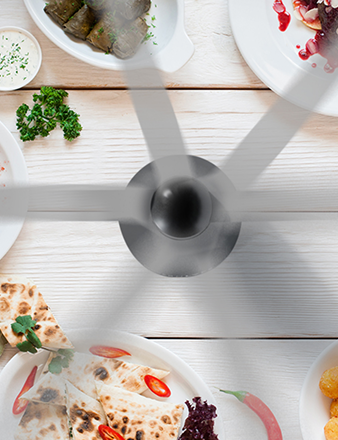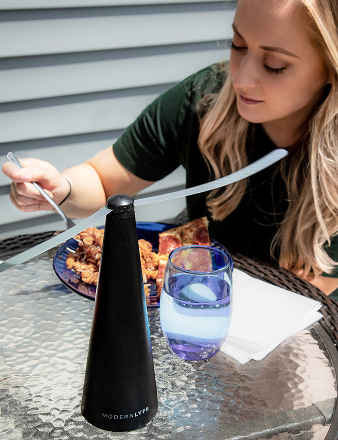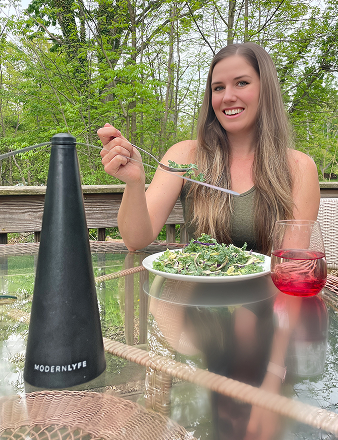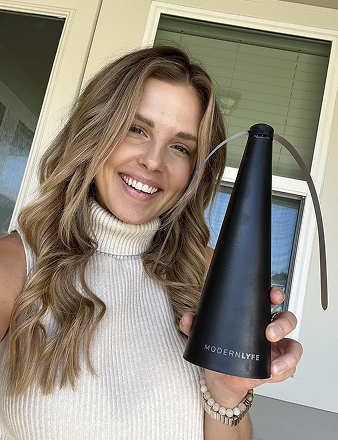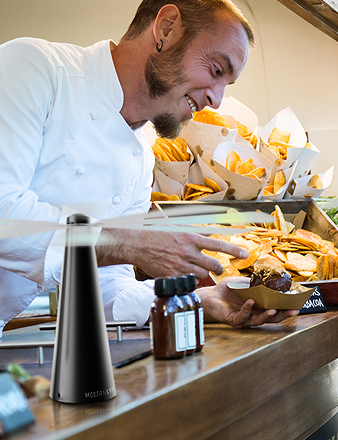Ready to sell at a farmers market? Before you stock up on produce or handcrafted goods, you need to understand the farmers market vendor requirements. Think of them as the five pillars of your business: legal, health, market, product, and financial. Master these, and you'll build a business that’s ready for success.
Your Roadmap to Becoming a Farmers Market Vendor
Jumping into the farmers market scene can feel overwhelming. You have a long list of things to do—permits, licenses, applications, labels—and it’s easy to get lost. But with a clear, step-by-step approach, that chaotic checklist becomes a simple roadmap.
Think of it like building a house. You wouldn't put up walls before pouring a solid foundation. The same logic applies here. Each requirement is a building block, and understanding how they fit together helps you avoid costly mistakes. For example, knowing your product category first tells you which health permits you need, which directly impacts your startup budget.
The Five Pillars of Vendor Compliance
To make this journey simpler, let's break it down into five core pillars. This framework helps you organize your to-do list and tackle it one step at a time.
- Legal & Business: This is about making your business official. Get a business license, secure a seller's permit for sales tax, and get an Employer Identification Number (EIN) if you hire a team.
- Health & Safety: This is non-negotiable for anyone selling food. This pillar covers local health department permits, food handler cards, and practical safety like proper food temperatures and a hand-washing station.
- Market-Specific Rules: Every market has its own rulebook. Here, you’ll find details on stall fees, tent requirements, setup/teardown hours, and any product restrictions.
- Product Compliance: This is all about what you sell. It includes proper labeling with accurate ingredient lists and allergen warnings, plus knowing local regulations like Cottage Food laws, which dictate what you can produce in a home kitchen.
- Financial Readiness: This pillar covers your finances. Get the right liability insurance, have a reliable way to take payments (cash and card), and keep detailed sales records for tax time.
This diagram shows how these five pillars work together to create a compliant and successful market business.
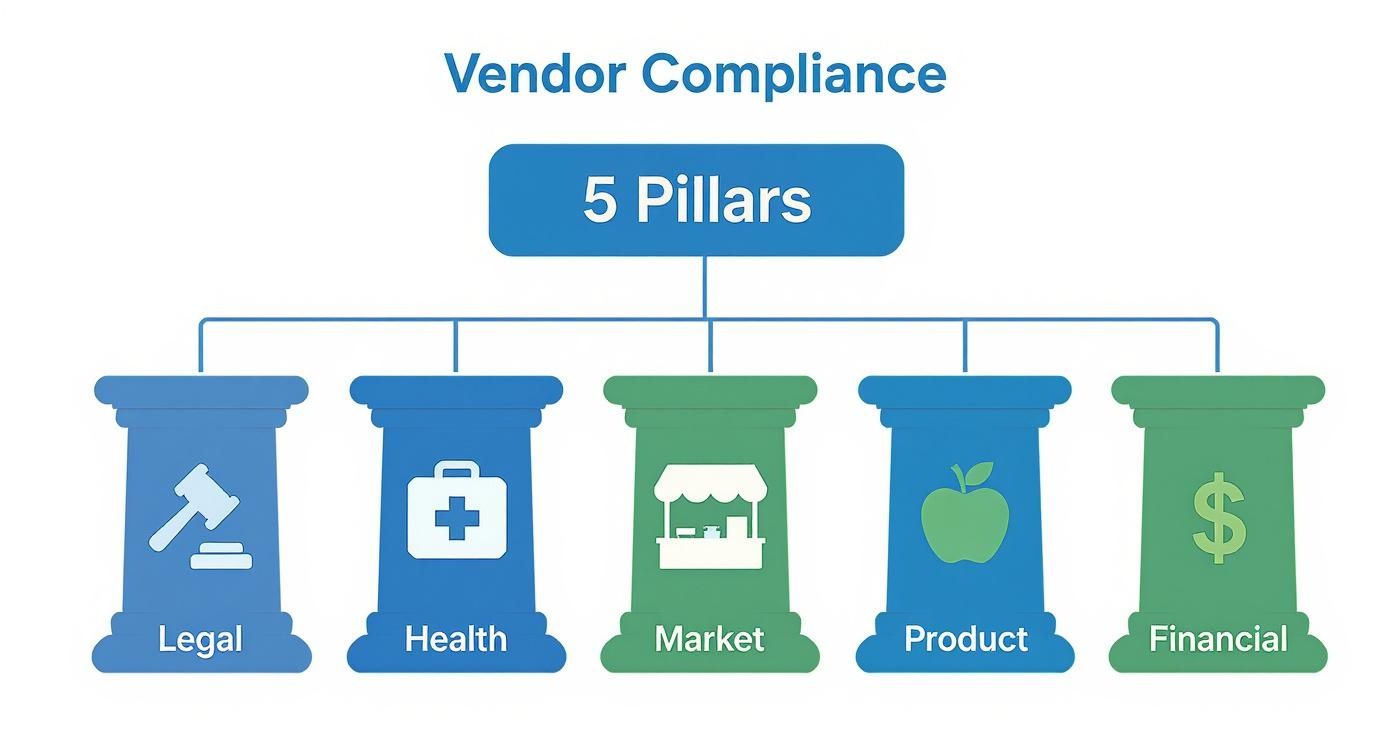
Here’s a quick summary of these essential pillars.
The 5 Pillars of Vendor Compliance at a Glance
| Requirement Pillar | What It Covers | Why It Matters |
|---|---|---|
| Legal & Business | Business licenses, seller's permits, and Employer Identification Numbers (EINs). | Establishes your business as a legitimate entity and ensures compliance with state and federal laws. |
| Health & Safety | Health department permits, food handler certifications, and on-site sanitation rules. | Protects public health, builds customer trust, and is legally required for selling food. |
| Market-Specific Rules | Booth fees, equipment standards (e.g., tent weights), and operational hours. | Ensures a smooth, safe, and fair experience for all vendors and shoppers at that specific market. |
| Product Compliance | Labeling laws, ingredient lists, allergen warnings, and production regulations. | Provides transparency for customers and ensures your products meet all legal sales standards. |
| Financial Readiness | Liability insurance, payment processing systems, and sales/expense tracking. | Protects your business from financial risk and keeps your accounting in order for taxes and profitability. |
Looking at the requirements this way makes it clear how interconnected they are. Each pillar supports the others, creating a solid foundation for your business. To understand why these rules exist from the organizer's view, learning the basics of planning an event can offer valuable insight.
Navigating Licenses, Permits, and Insurance
Think of licenses, permits, and insurance as the official foundation for your market stall. Sorting through paperwork isn't fun, but these documents are the non-negotiable bedrock that makes your business legal, legitimate, and safe.
Skipping this step isn't just risking a fine—it's risking your entire business before you make your first sale. But the process is less intimidating when you tackle it piece by piece. Each document has a clear purpose, and understanding what's what is the first step. This isn’t just red tape; it’s the framework that lets you operate with peace of mind.
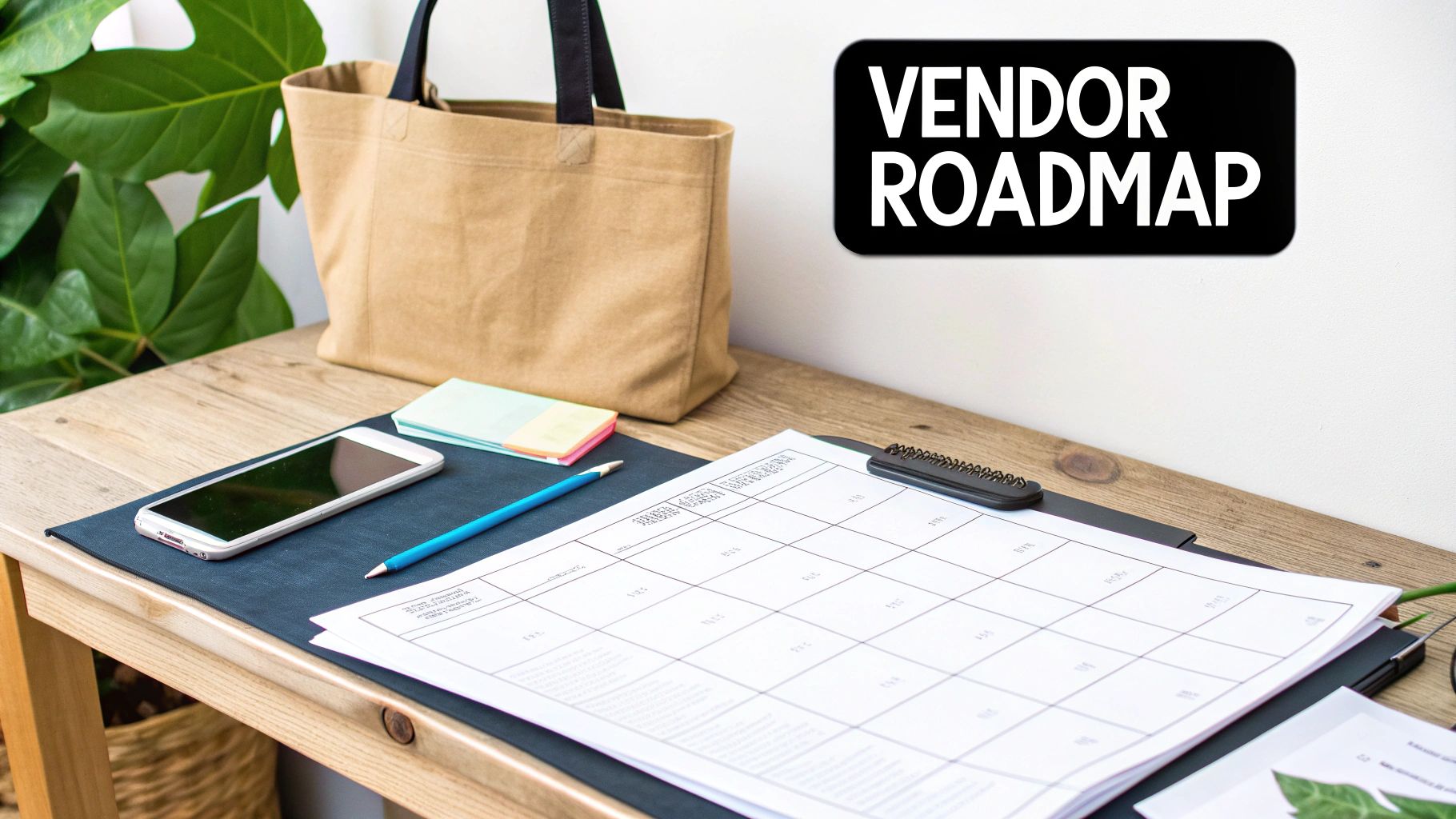
The Three Core Legal Documents
At a minimum, you’ll need to get a few key documents in order. These are the absolute basics for operating legally almost anywhere. The exact names might vary by location, but their function is universal.
-
Business License: This is your official green light from your city or county to operate a business. It’s often the very first thing you need. Think of it as a driver's license for your business—it proves you’re recognized by local authorities.
-
Seller's Permit (or Sales Tax Permit): If you’re selling products, the state requires you to collect sales tax. This permit gives you the authority to do so. You're essentially acting as a tax collector for the state, and this document makes it official.
-
Food Handler's Permit/Card: This is a must-have for anyone selling food, from baked bread to fresh berries. This certification shows you and your team are trained in food safety essentials, assuring inspectors and customers that you handle food properly.
Getting these legal documents is now standard practice. The global street vendors market is projected to grow from $3.0 billion in 2025 to $5.3 billion by 2035, and that growth is driving the industry toward more professional, regulated operations. You can explore the full analysis on Future Market Insights to see how much this space is expanding.
Demystifying Liability Insurance
Now, let's talk insurance. Beyond permits, general liability insurance is the single most important investment for your business's security. It's the safety net between a simple accident and a lawsuit that could sink you.
Key Takeaway: Liability insurance isn't a "nice-to-have." For most markets, it's mandatory. It protects you if a customer gets hurt at your booth or has a negative reaction to a product.
Imagine a customer trips over your tent leg, or a child has an allergic reaction to a sample. Without insurance, you'd be personally on the hook for medical bills and legal fees. One unlucky moment could wipe out your profits and put your personal savings at risk.
Most market managers require proof of insurance, often with a minimum coverage of $1,000,000. They'll also likely ask to be listed as an "additional insured" on your policy, which protects the market if an incident occurs at your booth. While this can seem complex, our guide on food truck permit requirements has great insights that apply to any mobile food vendor.
A Practical Checklist for Getting Started
Feeling overwhelmed? Don't be. Here’s a simple plan to get your paperwork done without the headache.
- Step 1: Research Local Rules. Start at your city, county, and state government websites. Search for "business license," "seller's permit," and "health department" to find the right forms.
- Step 2: Talk to the Market Manager. Your market manager is your best resource. Ask for a checklist of every required document, including specific insurance coverage amounts.
- Step 3: Apply for Licenses and Permits. Get your local business license first, then the state seller's permit. You can usually apply for these online.
- Step 4: Get Insured. Find an insurance agent who works with small businesses or food vendors. They'll know exactly what type of general liability policy you need to meet market rules.
- Step 5: Organize Your Documents. Keep digital and paper copies of everything. You’ll need to show them to the market manager and have them on hand at your booth.
Mastering Food Safety and Product Rules
https://www.youtube.com/embed/GeGGuJ2D_4E
When you sell food, trust is everything. It's the invisible ingredient in every product you offer. Food safety rules aren't just red tape; they are the roadmap to earning and keeping that customer trust.
Mastering the rules shows you’re a professional who takes customer well-being seriously. It's about knowing everything from health department permits to the fine print on your product labels. Get this right, and you'll build a loyal following.
Health Permits and Food Handler Certifications
Your first stop should be your local health department. Before you sell your first product, you need their approval. They are the gatekeepers of public food safety.
A health department permit is their official confirmation that your operation is clean, safe, and up to code. On top of that, most jurisdictions require at least one person at your booth to have a food handler certification. This is usually a simple, low-cost online course covering the essentials: proper handwashing, avoiding cross-contamination, and maintaining safe food temperatures. It’s an easy way to show you mean business.
Cottage Food Laws: The Home Kitchen Advantage
The cost of renting a commercial kitchen can be a major hurdle for new vendors. That's where Cottage Food Laws are a game-changer. These state-specific laws allow small-batch producers to prepare certain "low-risk" foods in their home kitchens.
What is a "low-risk" food? It’s anything that doesn't spoil easily or support harmful bacteria growth.
- What's Usually Allowed: Baked goods without creamy fillings (cookies, breads), jams, jellies, honey, and some candies.
- What's Usually a No-Go: Anything requiring refrigeration for safety. This means meats, dairy, cheesecakes, and items with cooked vegetables are typically off-limits and must be made in a licensed commercial kitchen.
These laws vary by state, so you must check your local rules. They often include annual sales caps and strict labeling guidelines. For a deeper look at the systematic thinking that keeps any food business safe, our article on what is HACCP food safety is a great resource.
Labeling and Packaging Requirements
Clear, honest labels are a legal requirement, not just a nice touch. Your customers need to know what they're buying, and your label is your direct line of communication.
Key Insight: Great labeling is about transparency, not just compliance. Clear ingredient lists and allergen warnings build powerful customer trust.
Your labels must include the basics:
- The product name.
- Your business name and address.
- A full list of ingredients, ordered by weight.
- A clear warning for major allergens (e.g., "Contains: wheat, milk, nuts").
- The net weight or volume.
Your packaging is just as important. It must protect your food, keep it fresh, and be durable enough for the trip home. It's the first thing customers see, so make sure it reflects the quality inside. Speaking of protection, it's smart to look into product liability insurance; it’s a crucial safety net for any food vendor.
With over 9,500 farmers markets in the U.S. generating around $1.4 billion annually, this is a serious business. Meeting these professional standards is what separates hobbyists from successful entrepreneurs.
Designing a Compliant and Successful Booth
Your booth is your storefront, your stage, and your entire operation in one compact space. It's your first impression on customers and ground zero for a health inspection. Getting your booth design right is one of the most critical farmers market vendor requirements, balancing safety, efficiency, and sales appeal.
Your 10x10 foot space is a mini retail shop where every item must earn its spot. From the canopy above to the coolers below, a smart setup doesn't just pass inspection—it makes your day smoother and creates a better experience for shoppers.
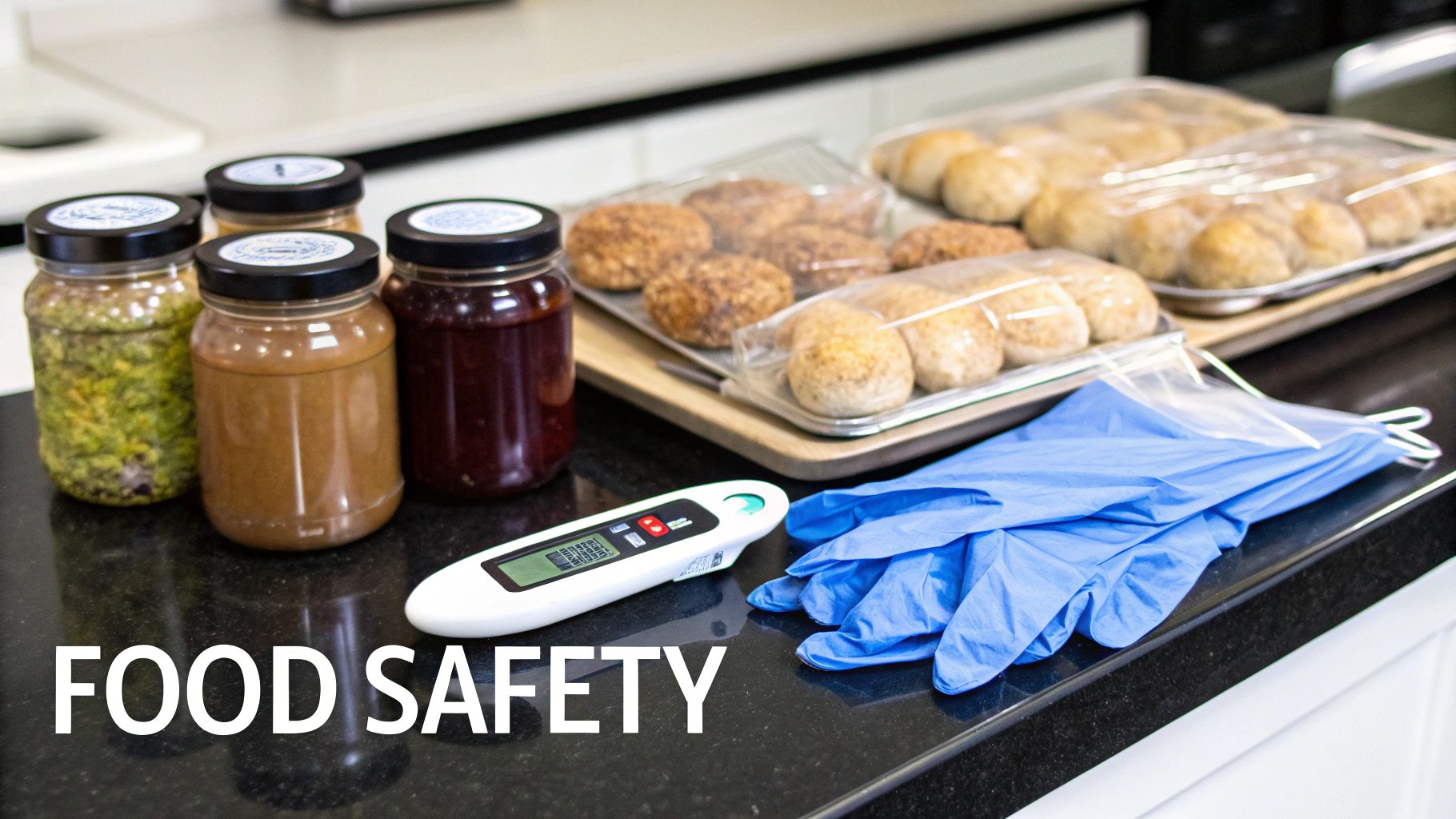
Tent and Table Fundamentals
Your canopy's most important job is safety. Markets are strict about this for good reason: a tent that takes off in a gust of wind is a massive liability. That's why secure tent weights are non-negotiable.
Most markets require a minimum of 25-40 pounds of weight on each of your tent's four legs. Don't use loose bricks or flimsy water jugs. Professional canopy weights or heavy-duty sandbags are the standard. It’s also wise to ensure your tent's fabric is fire-retardant, especially if you use any cooking equipment.
Your tables are where you display goods and serve customers. They must be made from a non-porous, easy-to-sanitize material like stainless steel, food-grade plastic, or sealed wood. While fabric tablecloths look nice, any surface touching open food must be smooth and wipeable.
Essential Booth Equipment Checklist
Beyond your tent and tables, you'll need specific gear to stay compliant, especially when selling food. Health inspectors and market managers have a mental checklist when they walk by, and you want to have all your bases covered.
This table breaks down the must-have equipment for safe operation.
| Equipment Item | Primary Purpose | Common Requirement |
|---|---|---|
| Hand-Washing Station | Sanitation and hygiene for vendors. | A container with a spigot for running water, a catch bucket, soap, and paper towels. |
| Proper Coolers | Temperature control for perishable goods. | Insulated coolers with ice packs or thermometers to keep cold foods below 41°F (5°C). |
| Fire Extinguisher | Fire safety for cooking vendors. | A certified and inspected fire extinguisher (typically Class K) within easy reach. |
| Trash Receptacle | Booth cleanliness and waste management. | A dedicated, covered trash can for your booth’s waste. |
| Protective Barriers | Food protection from contaminants. | Sneeze guards or clear coverings for any open food samples or ready-to-eat items. |
Having these items shows you're a professional who takes public health seriously.
Creating an Efficient and Inviting Space
Once you have the required equipment, arrange it into a space that works for you and welcomes customers. A cluttered, chaotic booth is a turn-off for shoppers and a nightmare to work in.
Your layout should guide customers naturally, while your "back of house" area stays organized and out of sight. Try putting your payment station at one end and samples at the other to encourage people to walk your full display. Store extra inventory neatly under tables.
Pro Tip: Keep your booth tidy and pest-free. A discreet, tabletop fly fan can be a lifesaver for keeping insects off your products and samples without loud zaps or chemicals, creating a clean and professional image.
Remember, a visually appealing booth is just as crucial as a compliant one. Clear signage, an attractive display, and a friendly face go a long way in turning passersby into loyal customers. For more ideas, check out our in-depth guide to creating a standout farmers market booth setup.
Why Vendor Rules Vary by Location
A common mistake new vendors make is assuming all markets have the same rules. This "one-size-fits-all" thinking leads to compliance headaches. The truth is, farmers market vendor requirements are intensely local and can change dramatically across state, county, or even city lines.
Think of it like local dialects. Everyone speaks the same language of commerce, but the specific phrasing and customs shift from one area to the next. What's acceptable in a small, rural market could be a major violation in a busy urban center just an hour away.
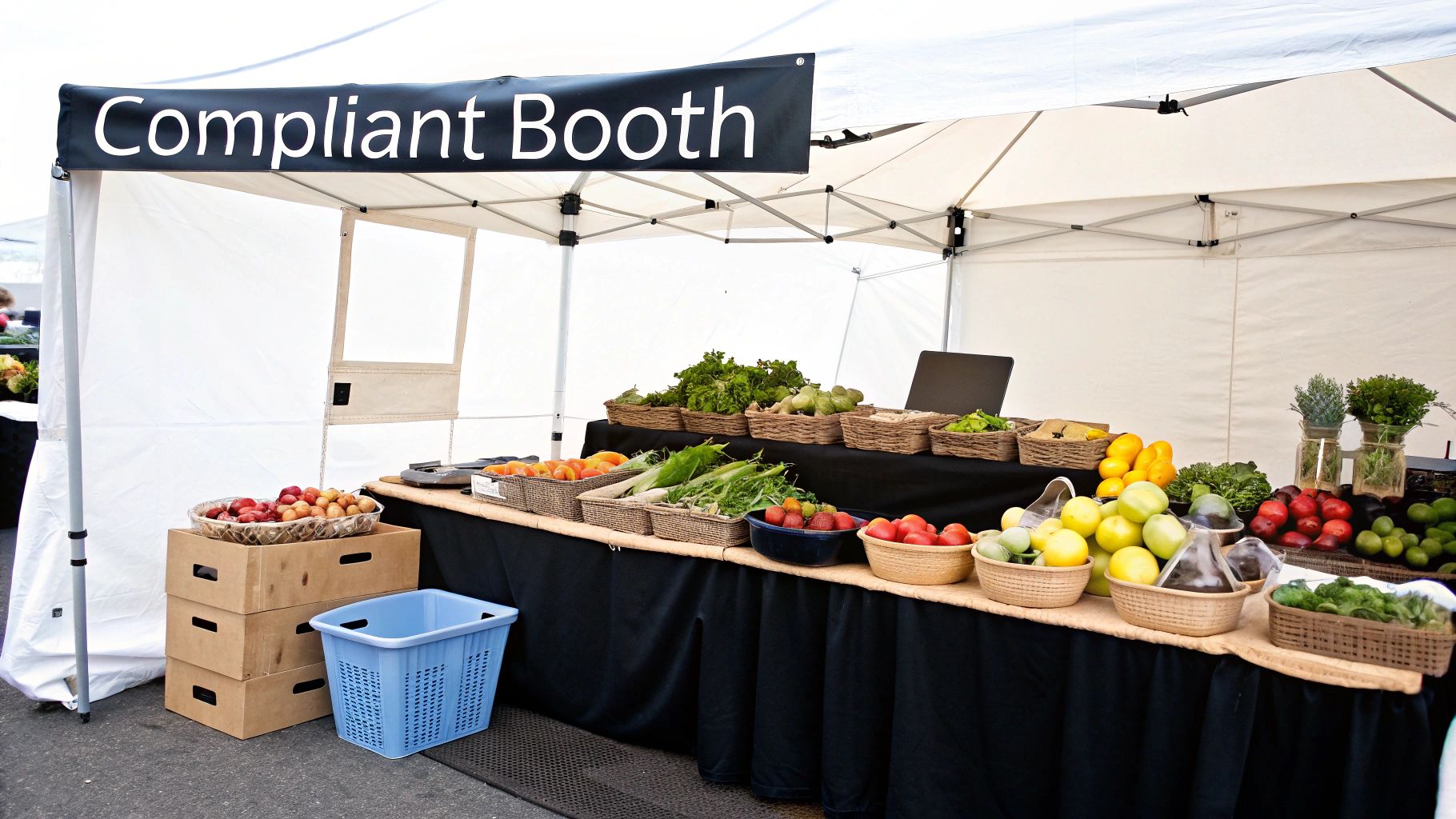
State and County Regulations
The big-picture rules usually come from your state and county health departments. These agencies set the baseline for public health and safety.
- State Laws: These provide the broad framework. For example, a state's Cottage Food Law defines what you can produce in a home kitchen for public sale and may set a general sales cap for all cottage food vendors statewide.
- County Ordinances: This is where the rules get specific. Your county health department is likely the agency you'll deal with for permits and inspections. They take state laws and often add their own requirements based on local needs.
For instance, a state might allow the sale of unpasteurized cider. But if a specific county has a history of related foodborne illness outbreaks, they can—and often will—ban its sale within their jurisdiction. That's why your research must start locally. The county health department’s website should be your first stop.
Market-Specific Bylaws
On top of government regulations, each farmers market has its own rulebook. These bylaws are created by the market manager or board to cultivate a specific atmosphere, ensure fair competition, and maintain quality for shoppers.
A market’s rules define its personality. Some are strictly "producer-only," meaning you must have grown or made everything you sell. Others might allow a percentage of resale items to offer more variety. Never assume; always ask for the official vendor handbook.
Market size also plays a huge role. Data from the National Farmers Market Manager Survey shows how different markets can be. For example, markets in the Rocky Mountain region tend to be larger, with over a third having 40 or more vendors. In the Northeast, only 6% of markets reach that size. A bigger market often means more complex logistics and stricter safety rules. You can dig into these regional market variations and their impact to learn more.
Key Questions to Ask Every Time
To avoid costly surprises, treat every new market application like a fact-finding mission. Arm yourself with a consistent set of questions to get the exact information you need.
- Who is my primary regulatory contact? Is it the city, county, or a state agency?
- Can I see a copy of the official market rules? Get the vendor handbook before you apply.
- Are there product-specific rules I should know? Ask directly about any special regulations for items like eggs, meat, or dairy.
- What are the exact insurance requirements? Confirm the required liability coverage and ask if the market needs to be named as an "additional insured" on your policy.
Asking these questions from the start helps you build a clear compliance checklist for each market. You'll show up prepared, professional, and ready to sell.
Your Top Questions, Answered
Let's tackle the questions that pop up as you get into the details of selling at a farmers market. You have the big dream, but what about the practical, day-to-day realities? Here are the answers to the most common questions from new vendors.
Think of this as your final gear check. We're tightening the last few bolts to make sure you’re ready for the "what if" moments.
How Much Does It Really Cost to Get Started?
This is the big question: the budget. The good news is that launching a market booth is far cheaper than a brick-and-mortar shop. But the costs are real, and you need to plan for them.
Your total investment is a mix of one-time startup costs and recurring expenses. While every market is different, here’s a realistic breakdown.
Upfront, One-Time Costs:
- Permits & Licenses: $50 to $500, depending on your location and what you sell.
- Tent & Weights: $200 to $400 for a quality 10x10 canopy with proper weights. Don't cut corners here.
- Tables & Display: $100 to $300 for sturdy tables, tablecloths, and display items like baskets or shelves.
- Coolers & Sanitation: $100 to $250 for good coolers and a hand-washing station.
- Payment System: $0 to $50 to get started with a simple card reader from a platform like Square.
Ongoing Monthly Expenses:
- Stall Fees: Varies widely, from $25 to $100+ per market day.
- Liability Insurance: A standard policy typically runs $30 to $60 per month.
- Supplies: Includes ingredients, packaging, and gas. This depends entirely on your sales volume.
For a new vendor not cooking on-site, a realistic starting budget is between $750 and $2,000. This covers your essential gear and first month, letting you start strong.
What are Health Inspectors Really Looking For?
A health inspector's visit doesn't have to be stressful. Most inspectors aren't out to get you; their job is to protect the public. The secret is knowing they almost always check for the same common mistakes.
Master these, and you’ll pass with flying colors. Here are the top four things that trip up new vendors:
- Mistake #1: The Hand-Washing Station Fail. It's not enough to have soap and a water jug. They need to see running water (from a spigot), a catch bucket for the wastewater, soap, and single-use paper towels.
- Mistake #2: Improper Temperatures. This is a big one. Cold foods must be at or below 41°F (5°C), and hot foods must stay at 135°F (57°C) or hotter. Get a reliable food thermometer and use it frequently.
- Mistake #3: Missing or Sloppy Labels. Inspectors check labels for required info, especially a full ingredient list with clear allergen warnings. Forgetting this can get your products pulled from sale immediately.
- Mistake #4: An Unsecured Tent. This is a public safety hazard. A tent without heavy-duty weights on every leg is a major violation that can get you shut down on the spot.
Nailing these four things shows the inspector you’re a serious, responsible business owner.
Can I Sell Things I Didn't Make Myself?
This is a great question that gets to the heart of a market's identity. The short answer? It depends entirely on the market's rules.
Many farmers markets are strictly "producer-only."
A producer-only rule means you must have grown, raised, or made everything you sell. This rule keeps the market authentic, guaranteeing customers are buying directly from the source. A baker uses their own recipes; a farmer sells produce from their own fields.
However, some markets are more flexible and allow a limited amount of reselling. For example, a farm stand might be permitted to sell a small quantity of berries from a neighboring farm to broaden their selection. But transparency is always key.
Always check the vendor handbook or application for the market's specific policy on reselling. When in doubt, ask the market manager. Being upfront about your product sources builds trust with everyone.
What’s the Best Way to Approach a Market Manager?
Your first email to a market manager is your first impression. Make it count. They are busy gatekeepers looking for professional, prepared vendors who are a good fit. A vague, sloppy email is the fastest way to be ignored.
Before you write, do your homework. Read their website and vendor application thoroughly. It shows you respect their time.
Here's a simple, professional formula that works:
- Write a Clear Subject Line. Use something direct like, "New Vendor Inquiry - [Your Business Name]."
- Keep the Introduction Short. Say who you are and what you sell. Attach a few high-quality photos of your products and booth setup.
- Show You're Serious. Mention that you've read their application and either have or are getting the required licenses and insurance. This proves you mean business.
- Ask Smart Questions. If you have questions, make sure the answers aren't already on their website. It's better to ask about their vendor selection timeline than to ask about the stall fee.
This thoughtful approach sets you apart and shows the manager you would be a great addition to their market.
A clean, professional, and pest-free booth is a non-negotiable part of meeting farmers market standards. To give your customers the best possible experience, consider a discreet way to keep flies off your goods. MODERN LYFE makes stylish, quiet tabletop fly fans that protect your food without the noise or chemicals. They blend right in with your display. Find the perfect fly fan for your stall at modernlyfe.com.

